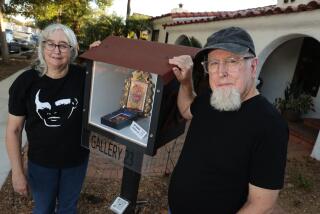THE ARTS WARS : Locals Losing the Money Game : State officials say Ventura County government leaders “need educating” about pursuing and providing money.
When state officials hand out arts money, government records show, Ventura County’s arts groups get a below-average share.
And when the county weighs such spending, arts leaders say, they fare even worse.
State arts officials blame both shortfalls on Ventura County government leaders.
Money, they say, may be tight, but most comparable counties have been able to find more than Ventura County supervisors have.
“They need educating,” said Gloria Woodlock, manager of state-local partnership programs for the California Arts Council. “Ventura and Orange counties seem to be the ones I’ve had the hardest time with. It’s been very difficult to get them to understand that an investment in the arts is more than just window-dressing.”
Richard Wittenberg, Ventura County’s chief administrative officer, acknowledged that “as a county becomes less rural and becomes more suburban or urban, the arts become more important.”
But with county finances so strapped and so many social issues needing attention, Wittenberg said he doubts an increase in county arts support is in the cards.
He suggested that support for the arts is a longstanding tradition among many of the counties that outspend Ventura.
U.S. Census figures show that Ventura County includes 669,016 residents, or 2.25% of the state’s population of 29.76 million.
Of the $10.5 million distributed in major 1989-90 grants by the state arts council, just $99,073 went to Ventura--0.94% of the state total.
Census figures show a population of 369,608 in Santa Barbara County, or 1.24% of the state total.
Yet arts groups there received $186,240 in 1989-90 state arts council major grants--1.77% of the state total.
To get state money, arts groups must file detailed applications, which are judged by peer panels made up of arts professionals from around the state.
The professionals assess arts groups’ strengths and potential, using a four-point scale, and give money to the most promising.
“That’s why you need a local arts agency. It’s the local arts agency that provides the technical assistance to improve operations,” Woodlock said.
For most of the 1980s, the Ventura County Arts Commission acted as the local agency in partnership with the state arts council, operating without a trained arts administrator on staff and drawing strong criticism from state officials who found the group unresponsive to the community.
“The county has a history of low funding,” said Maureen Davidson, executive director of the private, nonprofit Ventura Arts Council.
In 1987, amid a rash of criticism over the commission’s inactivity, the commission gave the job of being state-local partner to the Ventura County Arts Alliance, an arm of the private, nonprofit Ventura County Community Foundation.
As the Arts Alliance’s role has grown, its relationship with the state has improved, yielding almost $40,000 in grants in 1989-90.
That role is more tenuous since the Ventura County Community Foundation’s recent decision to streamline operations and let the Arts Alliance stand on its own.
The county of Ventura, meanwhile, still employs no trained arts administrators.
Officials said the county’s 1989-90 budget set aside $25,625 for arts grants, $20,000 of that to the Ventura County Museum of History and Art, the rest to the Arts Alliance as a contribution toward a countywide cultural plan.
“I can show you rural counties that are putting more money into the arts than Ventura County,” Woodlock said.
“Let’s see . . . San Bernardino County, $215,000; Sacramento Metropolitan Arts Commission, $460,000, and I think that’s gone up. Riverside Arts Foundation . . . $281,000.”
Arts administrators statewide say a coordinating local agency can be a key to an arts community’s growth, uniting organizations with common interests, passing along grants and sometimes acting as a lobbyist for the arts.
County governments in Sacramento, Fresno, Santa Clara, San Francisco, Santa Barbara and elsewhere sponsor such organizations.
Santa Barbara County granted its arts commission $151,000 last year, and the city of Santa Barbara added a larger amount.
Much of that was regranted to local arts organizations.
Other sources of potential support for the arts vary widely.
Local arts leaders have long complained that this county’s philanthropists give the arts less than their counterparts elsewhere, but no figures exist to confirm or refute the idea.
At the level of city government, arts leaders say, support varies widely.
In Ventura, officials passed along $75,000 in programming support to the private, nonprofit Ventura Arts Council and set aside another $10,000 for regranting to artists by the council.
Meanwhile, Harvey Roth, acting director of the Arts Alliance, noted that the cities of Camarillo, Moorpark and Simi Valley have declined to contribute any money to the alliance’s effort to draft a countywide cultural plan.
The California Arts Council handed out $10,531,000 statewide through its major arts grants programs in 1989-90.
The share that went to Ventura County was just under $100,000, compared to more than $180,000 to smaller Santa Barbara County. The grants broke down this way:
* Organizational Support.
In the state’s primary arts support program, officials in 1989-90 handed out $6,944,000 to 564 arts organizations.
In Ventura County, $19,500 went to the Ojai Festival, $5,760 went to the Ventura County Symphony, $3,360 went to the Santa Paula Theatre Center, $2,100 went to Illusions Outdoor Theatre, $1,384 went th the Ventura Arts Council and $1,000 went to the Ventura County Master Chorale and Opera Association.
In all, the six county groups received $33,104.
In Santa Barbara County, $19,200 went to the Santa Barbara Symphony, $18,144 to the UC Santa Barbara Arts and Lectures program, and $16,900 to the Contemporary Arts Forum.
Twelve other organizations won smaller grants.
In all, Santa Barbara’s 15 grants totaled $110,477.
* Artists in Residence.
The program, which subsidizes artists in schools, social institutions and community centers, made 194 grants in 1989-90 totaling $1,897,434.
Three artists in Ventura County won grants: Armando Garcia of Santa Paula got $9,500 for work with Teatro Inlakech in Oxnard, Javier M. Gomez of Oxnard got $9,500 for the Lucha Inc. theater group in Santa Paula, and Robert Hoard of Ojai got $3,200 for musical work at the Camarillo State Hospital and Development Center.
Ventura County’s total: $22,200.
In Santa Barbara County, three applicants won a combined $29,700.
* State-local partnerships.
Distributing grants to city and county arts agencies, state officials in 1989 handed out $1.49 million.
The Ventura County Arts Alliance got $39,769.
The Santa Barbara County Arts Commission got $44,063.
* Multicultural programs. Seeking organizations “deeply rooted in and reflective of an ethnic community,” state officials in 1989-90 distributed $200,000 among 100 groups statewide.
In Ventura County, grants of $2,000 each went to the Thalia Studio Theater group and the Ventura County Multicultural Arts Council, a Latino group.
In Santa Barbara County, one group won a single $2,000 grant.
THE MONEY FLOW
Ojai Festival
* Operating budget: From Aug. 1, 1989, to July 30, 1990, income of $250,560. Expenses of $356,060. Operating deficit of $105,500.
* Major revenue sources: Earnings from ticket sales, interest income, etc., of $67,990. Contributions from individuals, corporations and foundations of $136,470. Government grants of $46,100 (from the National Endowment for the Arts, the California Arts Council and $350 from the city).
* Audience: The three-day festival drew 3,498 people. Festival President Joan Kemper said 60% of them came from Los Angeles County, 26% from Ventura County, 8% from Santa Barbara County and 6% from elsewhere.
Ventura County Symphony
* Operating budget: From July 1, 1989, to June 30, 1990, income of $547,019. Expenses of $546,805. Operating surplus of slightly more than $200.
* Revenue sources: Earnings from ticket sales, interest income, etc., of $246,654. Contributions from individuals, corporations and foundations of $284,605. Government grants of $15,760 (from NEA and the state arts council).
* Audience: Some 13,000 people attended 15 subscription and pops presentations. Executive Director Karine Beesley estimates that 55% of the audience comes from the city of Ventura, 20% from Camarillo, 20% from Oxnard and the rest from Ojai, with Oxnard the fastest-growing audience base.
Beesley said the symphony’s goal over the next few years is to draw more listeners from the east end of the county.
Ventura County Museum of History and Art
* Operating budget: From Oct. 1, 1989, to Sept. 30, 1990, income of $304,804. Expenses of $326,555. Operating deficit of $21,751. Endowment funds of more than $700,000.
* Revenue sources: Earnings from bookshop sales, lectures, interest income and auxiliary activities of $63,229. Contributions, admissions and membership fees from individuals, organizations and foundations of $183,915. Government grants of $57,660 (from the federal Institute of Museum Services, the county of Ventura and the city of Ventura).
* Audience: Ed Robings, director of the museum, estimated that 60,000 adults and children visited in the year that ended Sept. 30. (The museum began seeking admission--$2 for adults, 50 cents for children--on July 4.) Of the museum’s 1,800 members (who pay $35 a year), 40 live in Santa Barbara County and virtually all the rest in Ventura County.
Santa Paula Theatre Center
* Operating budget for calendar 1990: Income $180,415, spending $179,448. Operating surplus of $967.
* Revenue sources: Earnings from ticket sales, concessions, interest income, etc., of $86,598. Contributions from individuals, organizations and foundations of $88,717. Government grants of $5,100 (from the state arts council and the Ventura County Arts Alliance).
* Audience: An estimated 10,000 people attended five adult and three children’s productions last year. A 1989 survey found that 37% of the theater’s audience came from Santa Paula, 24% from Ventura, 13.2% from Oxnard and Port Hueneme, 9.6% from Ojai, 6% from Fillmore, 3% from Camarillo, 2% from Moorpark and the rest from outside the county.
More to Read
The biggest entertainment stories
Get our big stories about Hollywood, film, television, music, arts, culture and more right in your inbox as soon as they publish.
You may occasionally receive promotional content from the Los Angeles Times.











